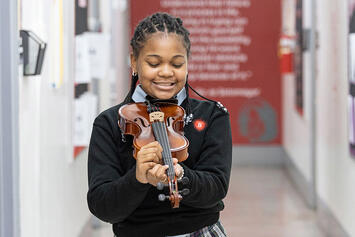
The streets of the South Bronx testify to the decay that has afflicted parts of modern American cities. In some ways, they resemble those of Mumbai more than those of gentrified Manhattan. Men lie prostrate outside empty storefronts or relieve themselves in broad daylight on the trash-strewn streets. It’s a hipster-less landscape of despair.
But it can also be a place of good works from those inspired by faith to meet dissipation with hope and a program of rejuvenation. At a time when big-city public schools are emptying, the Brilla Public Charter Schools offer Bronx parents an option that structures education along the lines of classical Catholic education—a model increasingly in demand these days. In 2021, Catholic schools saw enrollment growth of almost 4 percent.
At the suggestion of New York’s Cardinal Timothy M. Dolan, the Brilla schools were founded as a partial replacement for the 60 Catholic schools that the archdiocese had to close in 2011. Since 2019, Brilla’s four nonunionized Bronx-based schools, with a student body roughly 70 percent Latino and 30 percent black, have doubled enrollments, even as public school enrollment has declined by 23 percent. Two more Brilla schools are planned. “We have a totally different approach,” explains Denise McCrummen, principal of Brilla College Prep Elementary. “We have a code of conduct that wants something better from the kids and parents.”
Halfway across the country, in the sprawling Houston neighborhood of Sharpstown—a racially diverse community that struggles with crime and poverty—a similar scene unfolds. At the Saint Constantine School, built around the Eastern Orthodox Christian faith, children run free in a seven-acre yard, learning to garden or organizing their own games. Kids who might have been hobbled by a dysfunctional public school system are now immersed in a curriculum that includes instruction in Greek, Latin, or Arabic.
Like New York’s Brilla schools, Saint Constantine is growing rapidly—from 115 to 530 students enrolled since 2015. Houston’s troubled Independent School District, meantime, has lost 12 percent of its students since 2016. Made up largely of Middle Eastern Christian and Russian and Greek Orthodox students, the school focuses not only on academics but also on moral character—something rarely a priority for public schools. “We are trying to raise saints,” says Megan Mueller, VP of strategy and communications for the school. “Education is important, but building character is more so.”
Throughout the long history of cities, religion has played a central, even dominant, role, providing education, charity, and moral ballast in places where social chaos often flourishes. From the days of the earliest Mesopotamian cities to the modern metropolis, religion has served as a source of inspiration—as evidenced by structures from Saint Peter’s to Saint Patrick’s—and a consolation for populations that otherwise would be left to the vicissitudes of the mean streets or the cold mercies of the state. Even in an age of rationalist skepticism, religion remains indispensable to city life.
Religion is a central defining characteristic of civilizations,” observed the political scientist Samuel P. Huntington. Its importance shows in the evolution of the earliest cities in Mesopotamia, Egypt, India, and China. Religion defined a worldview that helped people cope with disasters and the fear of death, offering hope for immortality. It provided a moral code and a means of social cohesion. In many places, priests were the architects of the earliest urban order.
Throughout the many crises of antiquity, religious groups stepped in to play a philanthropic role. Often the only ones willing to treat the sick during a plague, Christians expanded their influence. Their selflessness, notes Rodney Stark, brought many to faith in a divine creator. Recurrent plagues, along with the general decline of Roman institutions, notes historian Kyle Harper, provided “a moment of truth for the traditional religions of the classical world, leading to the uncanny growth” of Christianity, a formerly “marginal religious movement.”
During the Middle Ages, the now-powerful Catholic Church, despite often-outrageous internal corruption, fed the poor, educated the populace, and cared for the sick. Until the advent of the modern nation-state, churches offered the charitable services needed by the urban poor. “The church, not the government,” observed Barbara Tuchman, “sponsored the care of society’s helpless.”
Other religions played similar roles in their geographical domains. Islam, like Christianity, mandated that the wealthy help the impoverished. “The believer’s shade on the Day of Resurrection will be his charity,” wrote the tenth-century Islamic scholar Al-Tirmidhi. To this day, Islamic charities are involved not only with education but also in the delivery of medical care, food, and other assistance to the needy.
Read the rest of this piece at City Journal.
Joel Kotkin is the author of The Coming of Neo-Feudalism: A Warning to the Global Middle Class. He is the Roger Hobbs Presidential Fellow in Urban Futures at Chapman University and and directs the Center for Demographics and Policy there. Learn more at joelkotkin.com and follow him on Twitter @joelkotkin.
Anthony Lemus is a professor of practice and director of industry relations at Chapman University’s Fowler School of Engineering.
Photo: A music student at Seton Education Partners, which runs 21 schools in New York, California, and Cincinnati that reflect Catholic values but operate independently of the Catholic Church. (Courtesy of Seton Education Partners)












